How’s your driving at the moment? Ice can be a treacherous thing: I once drove a brand new car into a lamppost on an icy, un-gritted road; resulting in £1,000 worth of damage and a severely dented ego!
In Britain, we don’t handle the cold weather very well; a flurry of snow or an icy day seizes our roads, railways and airports to a standstill. Every winter road-gritters work hard to keep us moving by spraying our roads with grit and salt. They’ve been doing it for over 50 years, but isn’t it a little strange that they’re still just using plain old salt? It damages cars , pollutes the environment and only really works down to about -5 degrees C! Surely science must have come up with something better than the stuff you put on your fish and chips?
Read on and never slip-slide away again…!
How does Grit Salt Work?
Something they told you at school: Water freezes at 0 degrees C. Here’s what they didn’t tell you: Only if the water is absolutely pure. If you mix anything with water, then it doesn’t freeze as well. If you can dissolve anything into water, it will lower the freezing point: Salt is cheap and easy to chuck on the roads, so that’s why most countries use it. Mix it with a bit of grit to give trucks better grip and hey-presto, you’ve made Grit Salt!
Grit Salt with Added Sugar!
A few years ago, they started adding sugar to grit salt. Why?!
Think back to the last time you stuck your fingers into a jar of chocolate spread (or ate an orange if you’re more civilised than me)! Remember that yucky sticky-finger feeling? Sugar is sticky!
This new ‘Safecoat’ grit salt comes coated with molasses (sugar) and sticks to the road much better. Which is great news, because gritters don’t have to use as much, it doesn’t pollute the environment as much because less of it gets washed away into fields, and not as much flicks up to dent our precious automobile!
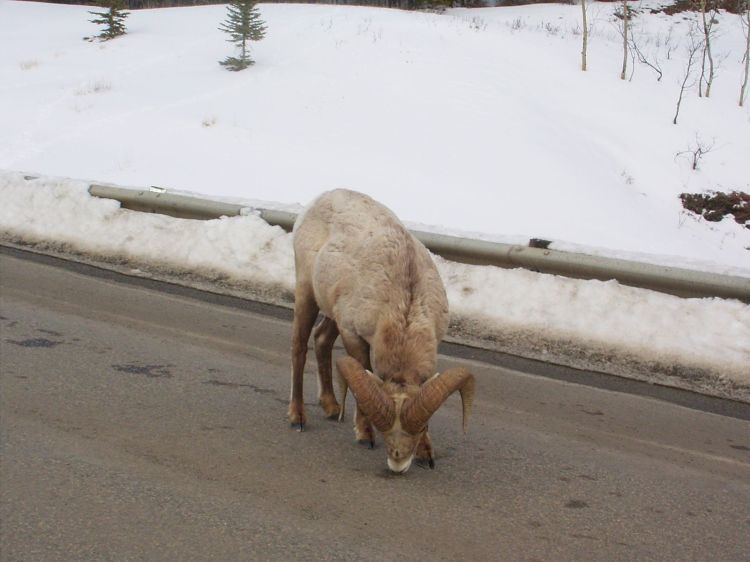
A sheep enjoying the sweet taste of sugary grit salt: They find it so tasty that they refuse to move for anything!
Alternatives to Grit Salt
There’s lots of different alternatives to salt, some are gritty powders others are spray-on liquids: Ranging from calcium chloride (from limestone) to magnesium chloride (which is also used to make tofu!). Most of them are pretty good de-icers but cost a lot more that simple rock salt. Some of them also cause some rather nasty pollution. Read more about all the different types here (some suppliers are listed below).
Self Heating Roads
Do you like the idea of a heated floor on a cold morning? I know I do! Just imagine swinging your legs out of bed on a cold morning and feeling a toasty warm floor beneath your tootsies! Eighty percent of houses in chilly Scandinavia have under-floor heating and it’s not a new idea: The Romans and Greeks were doing it over 3,000 years ago:
Even football and sports pitches have under-soil pitch heating! So could we do the same for roads? Well lots of scientists and engineers would say yes…
Engineers in Holland have built a system using pipes buried underneath the road tarmac. The idea is to capture heat from the road on hot days and recycle the heat to nearby buildings (or store it for warming the road in winter months).
Another idea is to heat roads using electricity. It’s been done in Houston, USA with tiny heating filaments (made out of carbon nanotubes) buried the road. The electricity bill is a bit steep though…
A team of researchers in Israel may have come up with a solution for generating the electricity to heat the road: by using the cars that drive over it! In just the same way a kinetic watch gets its power from body movements, Energy Generating Roads use the movement of vehicles to produce electricity! This electricity could be used to light street lamps or heat the road in winter time. Clever stuff!
Forget Snow Chains: Try Kevlar Tyre Socks!
Do you remember the Ig-Nobel prizes? I wrote a blog about this hilarious award given to the most amusing and ridiculous scientific discoveries earlier this year. This year’s winners for Physics ‘discovered’ that on icy footpaths people slip less if they wear socks on the outside of their shoes! It sounds ridiculour, but obviously someone was listening; because you can now buy Snow Socks for your car tyres!
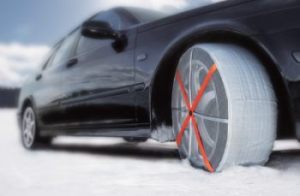
You can't drive faster than 50 mph with a snow sock on. If you don't want them to rip you should take them off when you get onto tarmac. Click image to watch a video of them in action!
Don’t go slip-sliding away!
Please stay safe in the ice: Don’t forget the importance of wearing socks on the outside of your shoes and don’t go making any of these driving mistakes…(try not to laugh too much)
Read more:
Read more about underfloor heating in your home here
Find out about Snow Socks here
Read more about changing the freezing point of water here
A good review of Snow Socks here
Buy De-Icers & Grit Salt:
One of the leading retailers in alternative de-icers is Peacock Salt
Other retailers include Icethaw, and Chemaide. Remember that some are pretty hazardous chemicals and potassium-based de-icers are similar to fertilisers!
Ig-Nobel Prize winning paper:
Parkin, L; Williams, SM; Priest, P (2009). “Preventing winter falls: a randomised controlled trial of a novel intervention”. The New Zealand medical journal 122 (1298): 31–8.

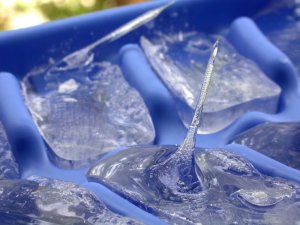
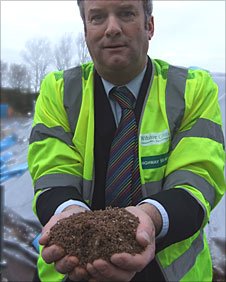


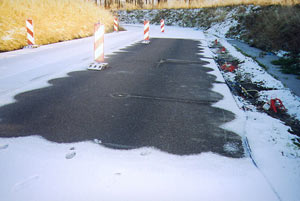










How funny - I bet snow snocks are a lot easier to fit than chains, too - and easier to drive with.
Posted by Robert | March 19, 2013, 5:54 pmi am studying pollution we choose salt . Do you have any advice for us ?
Posted by Melena Skahan | March 25, 2015, 5:52 pmWhat sort of advice are you after?
Posted by Stuart Farrimond | April 25, 2015, 5:20 am